COMMENT OF THE DAY RUNNER-UP: IT’S NOT WHAT YOU HAVE, IT’S HOW IT’S ATTACHED  “As an engineer who regularly performs inspections of homes/businesses, I don’t think there’s an issue with stucco itself. If properly installed and maintained, it works fine. Maintenance is just as important as installation, however most home owners do a poor job of regular maintenance on their house and just blame the builder for any issues that appear 5 years down the road. A good practice is to inspect and re-caulk any seals on the exterior of your house every year, preferably before the spring rainy season.
However, I wouldn’t go with the impermeable barrier system in Houston, which assumes that no moisture will get behind the wall (so there are no weep holes at the bottom). I’d rather have a ‘breathable’ building envelope, because keeping moisture out is very difficult with the soil conditions and climate we have in the area.” [Chase, commenting on Comment of the Day: Why Is Houston Still Stuck on Stucco?] Illustration: Lulu
“As an engineer who regularly performs inspections of homes/businesses, I don’t think there’s an issue with stucco itself. If properly installed and maintained, it works fine. Maintenance is just as important as installation, however most home owners do a poor job of regular maintenance on their house and just blame the builder for any issues that appear 5 years down the road. A good practice is to inspect and re-caulk any seals on the exterior of your house every year, preferably before the spring rainy season.
However, I wouldn’t go with the impermeable barrier system in Houston, which assumes that no moisture will get behind the wall (so there are no weep holes at the bottom). I’d rather have a ‘breathable’ building envelope, because keeping moisture out is very difficult with the soil conditions and climate we have in the area.” [Chase, commenting on Comment of the Day: Why Is Houston Still Stuck on Stucco?] Illustration: Lulu
Tag: Construction Materials

The chain link that has surrounded the former site of Corporate Plazas I, II and III since the wind-down of their protracted demise now appears to be getting augmented by some wooden fencing, a reader notes. The non-paved sections of the 4-ish-acre property bundle have picked up a layer of green since the final demo odds and ends finished up in May, giving that stack of pipes in the foreground something soft to lie down on.
Survey of the surrounding office space scene: That’s the crane at work on the office tower member of the Kirby Collection visible on the far left, over the parking-garage shoulder of the River Oaks Tower at 3730 Kirby (which, like the former Corporate Plaza land across Norfolk St., is owned by California-based Triyar). The 3701 Kirby office midrise is visible on the right from across Kirby Dr.; the kinda-matching 3801 Kirby is just out of the frame above, but visible in the shot below of the new fencing from the other side:
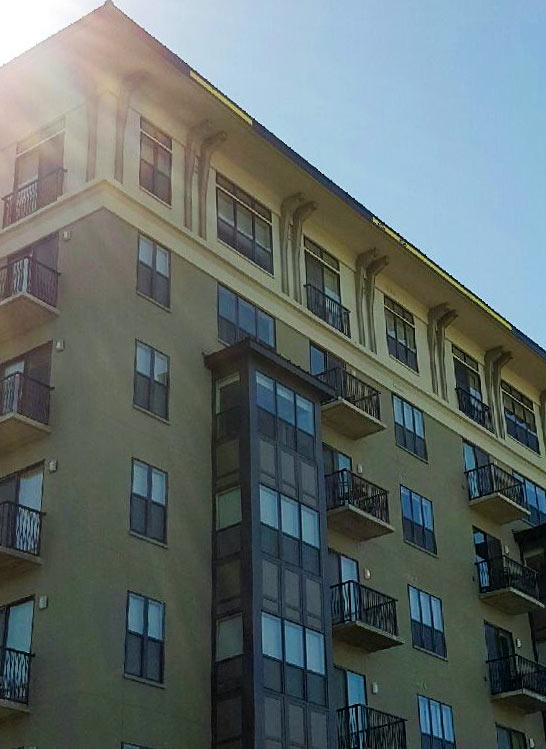
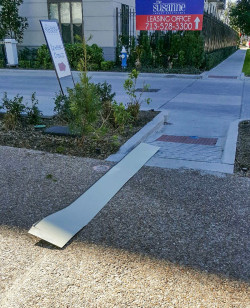
Highlighted in yellow along the top edge of The Susanne by the now-exposed construction materials beneath: some spots where metal flashing has been peeling off and escaping from the 8-story building at the corner of Dunlavy and W. Alabama streets. A pair of readers send photos and a report from some nearby offices this afternoon, after the latest of the metallic runaways crashed audibly onto the sidewalk out front: “They are metal and full of nails and are falling from 8 stories,” writes 1 of tipsters, adding that “this happened a few weeks ago as well.”
The Susanne opened about a year ago on the former grounds of the Dunlavy Fiesta. Another of the strips had already taken the plunge by about 7 AM this morning; the tipsters caught it curled up on the grassy strip next to W. Alabama:
COMMENT OF THE DAY: FLOATING THE STUCK-ON STONE BELOW THE STUCCO 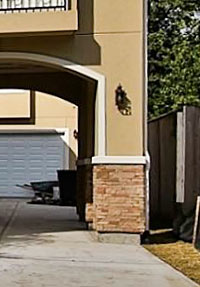 “Can just one builder find a way to transition a column [see photo detail at right] to the ground instead of the ridiculous ‘high-water’ pants look? It looks stupid and yet you see it everywhere. I assume for stucco construction it’s done to prevent water seeping/rot.” [Limestone, commenting on Wainscot World: Channeling the Paneling Within an Almost New Older Home in Mandell Place Seeking $1.35M] Photo: HAR
“Can just one builder find a way to transition a column [see photo detail at right] to the ground instead of the ridiculous ‘high-water’ pants look? It looks stupid and yet you see it everywhere. I assume for stucco construction it’s done to prevent water seeping/rot.” [Limestone, commenting on Wainscot World: Channeling the Paneling Within an Almost New Older Home in Mandell Place Seeking $1.35M] Photo: HAR
COMMENT OF THE DAY: TERRAZZO FOR FLIPPERS “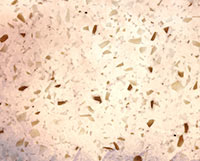 Poured terrazzo floors like those in that house are nowadays so astronomically expensive that the only new residential construction they are seen in today are high-end, architect-designed custom homes built for extremely wealthy people.
I wonder if people who replace poured terrazzo floors with hardwood, travertine, or whatever realize that they are discarding something very expensive for something much cheaper.
It even makes business sense. Even flippers could increase their profit margin if instead of replacing terrazzo, they just educated their buyers about how valuable these floors are. (Things that are revealed to be rare, expensive, and hard to replace have a way of magically becoming very attractive).” [august15, commenting on This Not-Screwed-Up-Yet Meyerland Ranch Mod, in Almost Original Condition, Is Available for $460K] Illustration: Lulu
Poured terrazzo floors like those in that house are nowadays so astronomically expensive that the only new residential construction they are seen in today are high-end, architect-designed custom homes built for extremely wealthy people.
I wonder if people who replace poured terrazzo floors with hardwood, travertine, or whatever realize that they are discarding something very expensive for something much cheaper.
It even makes business sense. Even flippers could increase their profit margin if instead of replacing terrazzo, they just educated their buyers about how valuable these floors are. (Things that are revealed to be rare, expensive, and hard to replace have a way of magically becoming very attractive).” [august15, commenting on This Not-Screwed-Up-Yet Meyerland Ranch Mod, in Almost Original Condition, Is Available for $460K] Illustration: Lulu
WHAT HAPPENS WHEN YOU STUCCOAT A BRICK SHOPPING CENTER IN COPPERFIELD 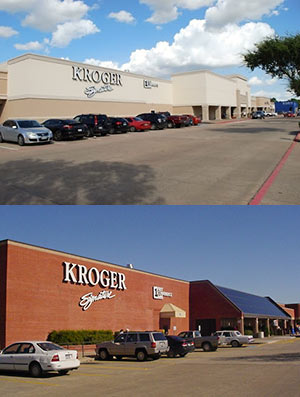 It’s not exactly a stucco jacket — a marketing brochure for the redone Easton Commons Shopping Center at the intersection of Hwy. 6 and West Rd. in Copperfield indicates the new coating and foam cornice (pictured at top) on top of the old brick structures (pictured at bottom) are actually Dryvit, a brand of EIFS, or a way to get that stucco look without all the layers and labor. (It’s Oyster Shell #456 above and Monastery Brown #381 below, plus Lantana Cobble Texas Stone on the columns, if you’re keeping score at home.) But Real Estate Bisnow’s Catie Dixon says the new brick-hiding exercise for the shopping center is “paying off” for its landlord: “in the five months since beginning renovations at Easton Commons, NewQuest’s Josh Friedlander and team have brought on eight new tenants totaling nearly 33k SF.” Among the newcomers drawn to all that relieving smoothness: Pet Club, UFC Gym, Beauty Empire, West Oaks Music Studio, and FJ Liquor. NewQuest Epic Investments will be building up a few freestanding buildings in the center facing Hwy. 6, Dixon reports, to make room for a new Smashburger, Verts Kebap, and a third unnamed restaurant, possibly (the brochure indicates) a Corner Bakery. [Real Estate Bisnow; brochure (PDF)] Photos: Catie Dixon (after); LoopNet (before)
It’s not exactly a stucco jacket — a marketing brochure for the redone Easton Commons Shopping Center at the intersection of Hwy. 6 and West Rd. in Copperfield indicates the new coating and foam cornice (pictured at top) on top of the old brick structures (pictured at bottom) are actually Dryvit, a brand of EIFS, or a way to get that stucco look without all the layers and labor. (It’s Oyster Shell #456 above and Monastery Brown #381 below, plus Lantana Cobble Texas Stone on the columns, if you’re keeping score at home.) But Real Estate Bisnow’s Catie Dixon says the new brick-hiding exercise for the shopping center is “paying off” for its landlord: “in the five months since beginning renovations at Easton Commons, NewQuest’s Josh Friedlander and team have brought on eight new tenants totaling nearly 33k SF.” Among the newcomers drawn to all that relieving smoothness: Pet Club, UFC Gym, Beauty Empire, West Oaks Music Studio, and FJ Liquor. NewQuest Epic Investments will be building up a few freestanding buildings in the center facing Hwy. 6, Dixon reports, to make room for a new Smashburger, Verts Kebap, and a third unnamed restaurant, possibly (the brochure indicates) a Corner Bakery. [Real Estate Bisnow; brochure (PDF)] Photos: Catie Dixon (after); LoopNet (before)
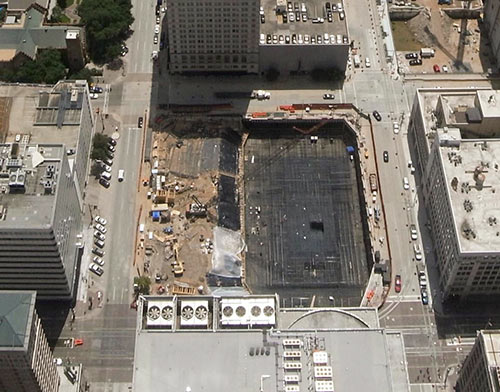
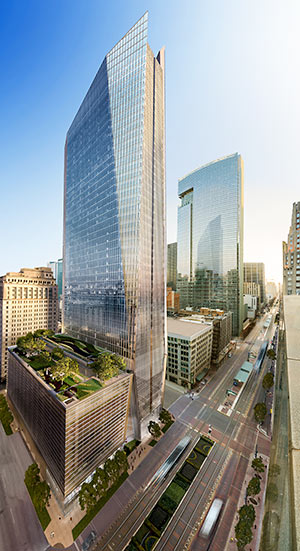 Update, 8/26: The headline has been corrected.
Update, 8/26: The headline has been corrected.
If you’re wondering what the late-night traffic holdup is in and around Main St. and Texas Ave. over the weekend, here’s your explainer: 180 mixing trucks are going to be lining up to pour a continuous stream of concrete onto this site surrounded by Main, Texas, Fannin, and Capitol streets downtown, where D.E. Harvey builders is putting together a little office building — now slated to rise 48 stories —Â for the Hines CalPERS Green development fund. The action starts at 7 pm on Saturday and should finish up around 3 in the afternoon the next day.
In all, about 14,000 cubic yards of concrete will go into the mat foundation of the 609 Main St. building during those 17 hours. The Texas Tower, formerly known as the Sterling Building, was dismantled on a portion of the site earlier this year.
- Previously on Swamplot: The Crane for the Crane for the Texas Building Demo Is Here; How the End Is Coming for Downtown’s Texas Tower; Bigger? Taller? Hines To Redesign Proposed 609 Main St. Office Tower; Does New Hines Highrise Mean Old Texas Tower’s a Goner?
Photo: Hines. Rendering: Pickard Chilton
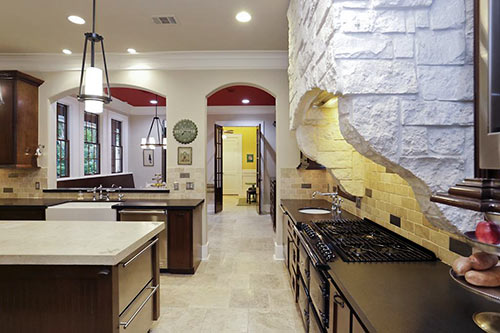
- 4929 Valerie St. [HAR]
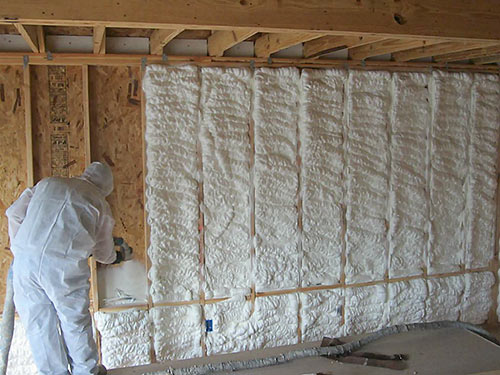
- 1916 Rosewood St. [HAR]
COMMENT OF THE DAY: GETTING RID OF WASTEFULNESS  “It amazes me that we’ve become so rich as a society that we can collectively afford to have fashions of home improvements that will go in and out of style (although remain perfectly functional) the same way clothes do. The funniest to me is when you see on one of these HGTV shows someone espousing all the right ‘green’ mantras, but the first thing they do when they get the house it tear out all the perfectly functioning appliances, cabinets, counters and carpet…etc to be thrown in a dumpster. All the while feeling smug about how sustainable the place is because they are putting in bamboo flooring . . .” [longcat, commenting on Comment of the Day: Your ‘Updates’ Are Dating You] Illustration: Lulu
“It amazes me that we’ve become so rich as a society that we can collectively afford to have fashions of home improvements that will go in and out of style (although remain perfectly functional) the same way clothes do. The funniest to me is when you see on one of these HGTV shows someone espousing all the right ‘green’ mantras, but the first thing they do when they get the house it tear out all the perfectly functioning appliances, cabinets, counters and carpet…etc to be thrown in a dumpster. All the while feeling smug about how sustainable the place is because they are putting in bamboo flooring . . .” [longcat, commenting on Comment of the Day: Your ‘Updates’ Are Dating You] Illustration: Lulu
COMMENT OF THE DAY: EVERYTHING NEW IS SO MUCH BETTER  “Your house was built in 1923? My condolences to you and your family. But do not despair, I know things seem now like it can’t get any worse, and it probably can’t, but one day with hard work and perseverance you will get out of the carcinogen and disease packed shelter of last resort and live in a actual house with modern plumbing and insulation. But do not wait too long, the current one can catch on fire and burn to the ground in mere minutes, due to that first growth wood, no fire blocking construction, and lack of sprinklers.” [commonsense, commenting on How It Was Before Air Conditioning Even] Illustration: Lulu
“Your house was built in 1923? My condolences to you and your family. But do not despair, I know things seem now like it can’t get any worse, and it probably can’t, but one day with hard work and perseverance you will get out of the carcinogen and disease packed shelter of last resort and live in a actual house with modern plumbing and insulation. But do not wait too long, the current one can catch on fire and burn to the ground in mere minutes, due to that first growth wood, no fire blocking construction, and lack of sprinklers.” [commonsense, commenting on How It Was Before Air Conditioning Even] Illustration: Lulu
BUILDING TRIVIA IN THE WOODLANDS  Real Estate Bisnow’s Catie Dixon reports a remarkable factoid about this 6-story, 154,213-sq.-ft office building that Stream Realty started construction on in August at 1585 Sawdust Rd. in the The Woodlands: When it’s done, writes Dixon, the so-called Reserve at Sierra Pines II, which is being built with 30-ft. panels swung into place by 300-ton cranes, will be the tallest tilt-wall building in Texas. [Real Estate Bisnow; previously on Swamplot] Rendering: Stream Realty Partners
Real Estate Bisnow’s Catie Dixon reports a remarkable factoid about this 6-story, 154,213-sq.-ft office building that Stream Realty started construction on in August at 1585 Sawdust Rd. in the The Woodlands: When it’s done, writes Dixon, the so-called Reserve at Sierra Pines II, which is being built with 30-ft. panels swung into place by 300-ton cranes, will be the tallest tilt-wall building in Texas. [Real Estate Bisnow; previously on Swamplot] Rendering: Stream Realty Partners
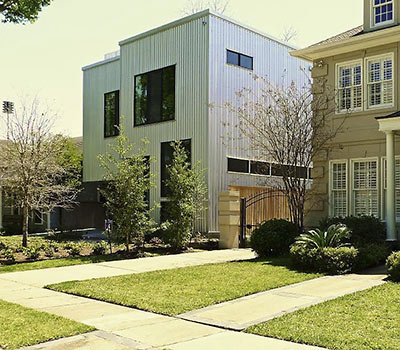
That steel frame on Centenary St. that roused some West U residents to name-calling and concern-raising 2 years ago now has a steel house built around it — and a single father and his two sons inside. Still, says architect Cameron Armstrong, the build wasn’t as smooth as it might have been: “[C]ertain neighbors were actually quite hostile — they heckled the subcontractors (and not always from across the street!), and made numerous frivolous complaints to the police about things like (non-existent) parking violations by workers. . . . They thought they were living on a street with a predictable visual future, which turned out not to be the case.” Adds Armstrong: “[I]t’s hard to identify substantive objections. . . . The good news is that most of the neighbors are just fine with how the design turned out.”
That there’s some pretty bad Feng Shui going down in this commercial for Honda, which was filmed in Vancouver and shown on teevee and the web beginning last October. The man behind the wheel of the CR-V sure is driving some bad chi into the gullet of the far-from-the-prairie home at the end of the T-intersection, to the encouraging narration of Garrison Keillor. But isn’t the house kinda asking for it anyway, what with all that glimmering vortex-popping and all?
And gee, doesn’t the hole stabbing through the house look a heck of a lot like . . . that temporary sculpture that stood on Montrose Blvd. in Houston a few years back? Portal to another dimension? Naah — from here it looks more like a shortcut to Grant St.
LOOKING FOR THE METAL STUDS IN HOUSTON  “I got nothing against wood,” writes a reader who says he worked in his uncle’s construction business for 12 summers while he was in school. “I really like the smell of fresh cut wood.” Still, he’s hoping Swamplot readers will be able to refer him to both architects and residential builders who are familiar with metal-frame construction — to help him build a new home for himself in the Memorial Villages area. He says he’s convinced metal-frame construction will last longer in Houston because of its inhospitality to termite dining and perhaps a lower risk of going up in flames. [Swamplot inbox] Photo: Super Stud
“I got nothing against wood,” writes a reader who says he worked in his uncle’s construction business for 12 summers while he was in school. “I really like the smell of fresh cut wood.” Still, he’s hoping Swamplot readers will be able to refer him to both architects and residential builders who are familiar with metal-frame construction — to help him build a new home for himself in the Memorial Villages area. He says he’s convinced metal-frame construction will last longer in Houston because of its inhospitality to termite dining and perhaps a lower risk of going up in flames. [Swamplot inbox] Photo: Super Stud

